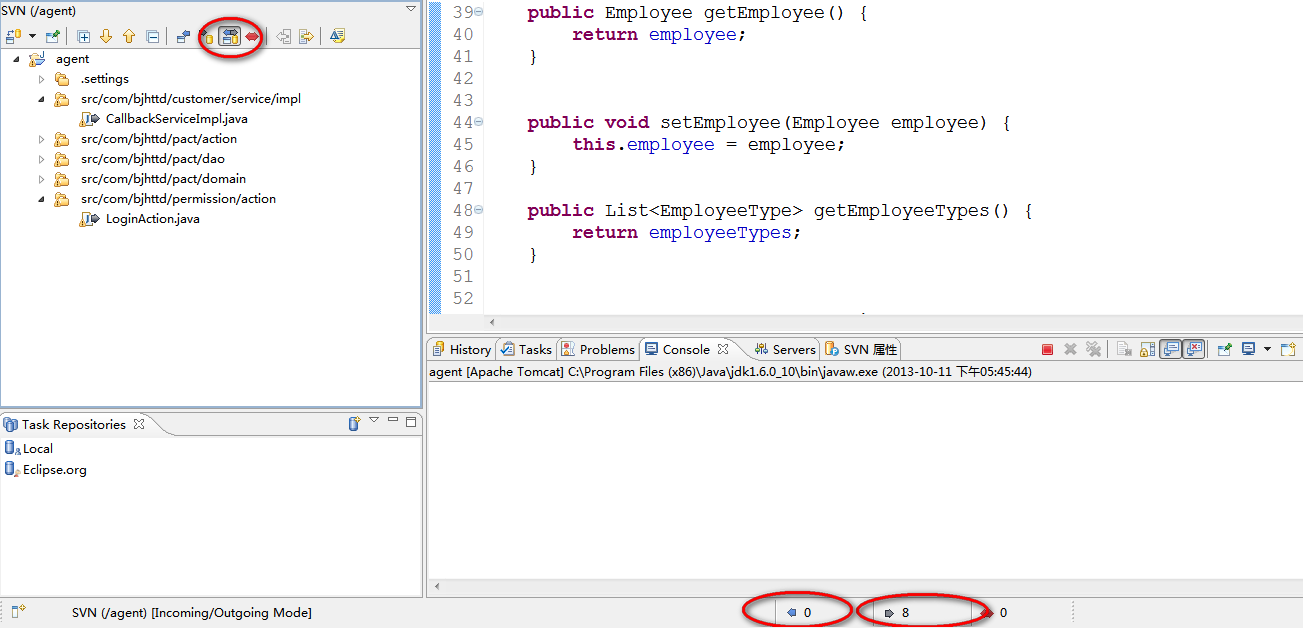HashMap、HashTable、LinkedHashMap和TreeMap
Java为数据结构中的映射定义了一个接口java.util.Map,它有四个实现类,分别是HashMap、HashTable、LinkedHashMap和TreeMap。本节实例主要介绍这4中实例的用法和区别。关键技术剖析:
Map用于存储键值对,根据键得到值,因此不允许键重复,值可以重复。
l (1)HashMap是一个最常用的Map,它根据键的hashCode值存储数据,根据键可以直接获取它的值,具有很快的访问速度。HashMap最多只允许一条记录的键为null,不允许多条记录的值为null。HashMap不支持线程的同步,即任一时刻可以有多个线程同时写HashMap,可能会导致数据的不一致。如果需要同步,可以用Collections.synchronizedMap(HashMap map)方法使HashMap具有同步的能力。
l (2)Hashtable与HashMap类似,不同的是:它不允许记录的键或者值为空;它支持线程的同步,即任一时刻只有一个线程能写Hashtable,然而,这也导致了Hashtable在写入时会比较慢。
l (3)LinkedHashMap保存了记录的插入顺序,在用Iteraor遍历LinkedHashMap时,先得到的记录肯定是先插入的。在遍历的时候会比HashMap慢。有HashMap的全部特性。
l (4)TreeMap能够把它保存的记录根据键排序,默认是按升序排序,也可以指定排序的比较器。当用Iteraor遍历TreeMap时,得到的记录是排过序的。TreeMap的键和值都不能为空。
import java.util.HashMap;
import java.util.Hashtable;
import java.util.Iterator;
import java.util.LinkedHashMap;
import java.util.Map;
import java.util.TreeMap;
public class TestMap {
public static void init(Map map){
if (map != null){
String key = null;
for (int i=5; i>0; i--){
key = new Integer(i).toString() + ".0";
map.put(key, key.toString());
//Map中的键是不重复的,如果插入两个键值一样的记录,
//那么后插入的记录会覆盖先插入的记录
map.put(key, key.toString() + "0"); }
}
}
public static void output(Map map){
if (map != null){
Object key = null;
Object value = null;
//使用迭代器遍历Map的键,根据键取值
Iterator it = map.keySet().iterator();
while (it.hasNext()){
key = it.next();
value = map.get(key);
System.out.println("key: " + key + "; value: " + value );
}
//或者使用迭代器遍历Map的记录Map.Entry
Map.Entry entry = null;
it = map.entrySet().iterator();
while (it.hasNext()){
//一个Map.Entry代表一条记录
entry = (Map.Entry)it.next();
//通过entry可以获得记录的键和值
//System.out.println("key: " + entry.getKey() + "; value: " + entry.getValue());
}
}
}
public static boolean containsKey(Map map, Object key){
if (map != null){
return map.containsKey(key);
}
return false;
}
public static boolean containsValue(Map map, Object value){
if (map != null){
return map.containsValue(value);
}
return false;
}
public static void testHashMap(){
Map myMap = new HashMap();
init(myMap);
//HashMap的键可以为null
myMap.put(null,"ddd");
//HashMap的值可以为null
myMap.put("aaa", null);
output(myMap);
} www.zzzyk.com
public static void testHashtable(){
Map myMap = new Hashtable();
init(myMap);
//Hashtable的键不能为null
//myMap.put(null,"ddd");
//Hashtable的值不能为null
//myMap.put("aaa", null);
output(myMap);
}
public static void testLinkedHashMap(){
Map myMap = new LinkedHashMap();
init(myMap);
//LinkedHashMap的键可以为null
myMap.put(null,"ddd");
myMap.put(null,"aaa");
//LinkedHashMap的值可以为null
myMap.put("aaa", null);
output(myMap);
}
public static void testTreeMap(){
Map myMap = new TreeMap();
init(myMap);
//TreeMap的键不能为null
//myMap.put(null,"ddd");
//TreeMap的值不能为null
//myMap.put("aaa", null);
output(myMap);
}

public static void main(String[] args) {
System.out.println("采用HashMap");
TestMap.testHashMap();
System.out.println("采用Hashtable");
TestMap.testHashtable();
System.out.println("采用LinkedHashMap");
TestMap.testLinkedHashMap();
System.out.println("采用TreeMap");
TestMap.testTreeMap();
Map myMap = new HashMap();
&n
补充:软件开发 , Java ,


